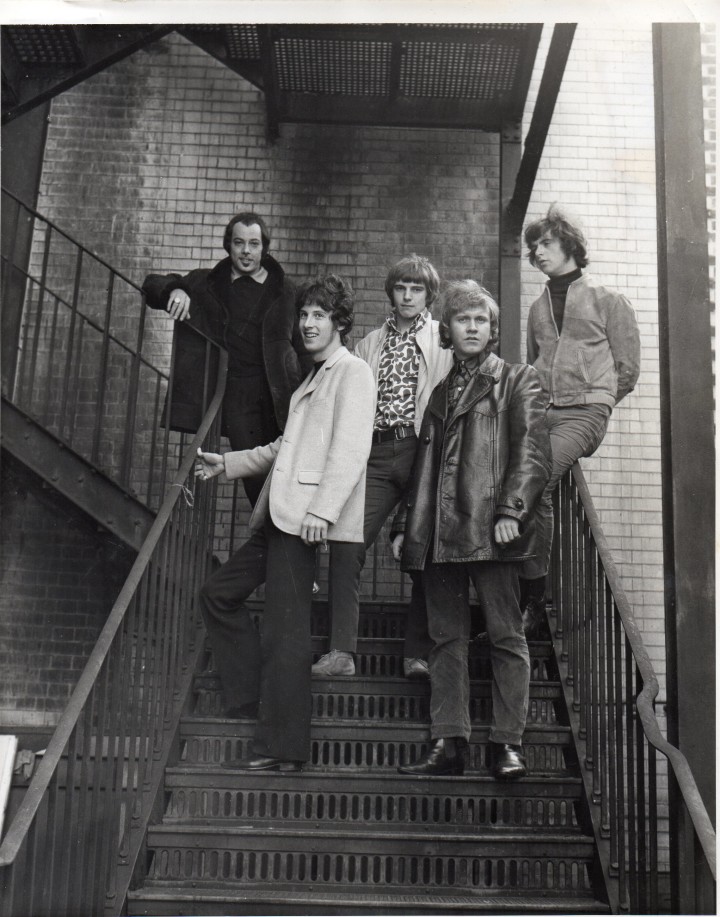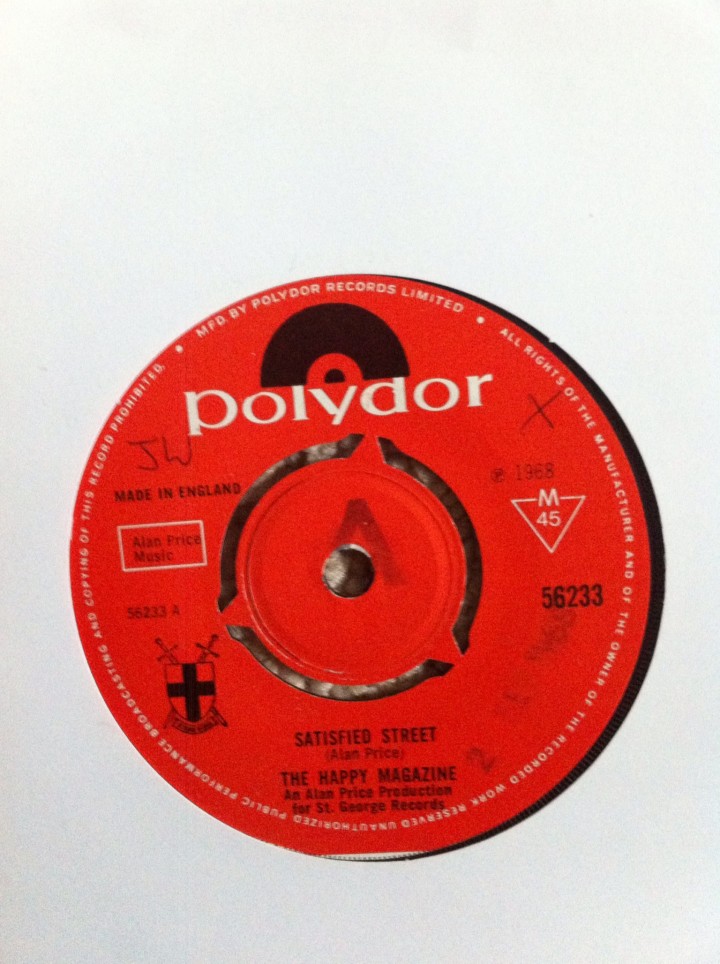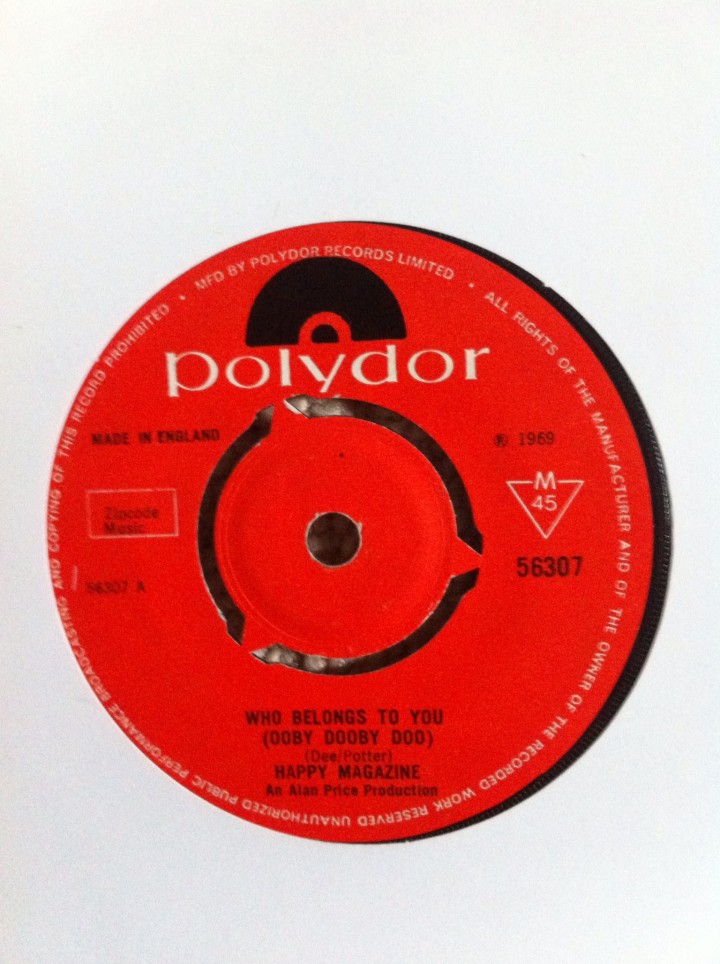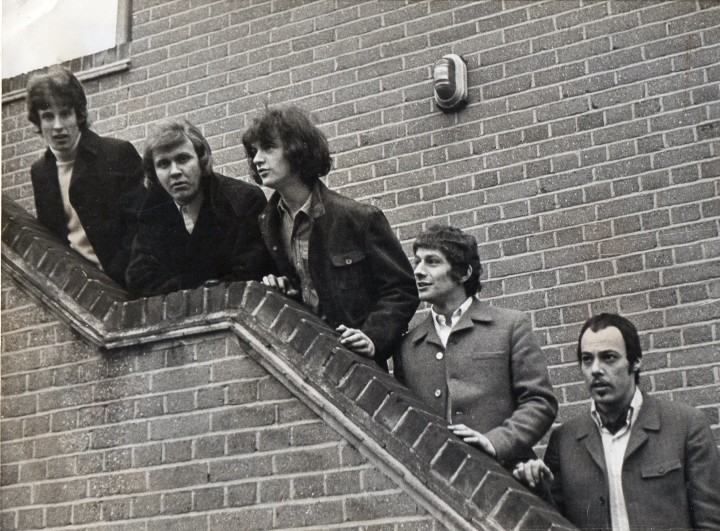
Formed in Bexley Heath, Kent in late 1963, The Loose Ends were fronted by singer Alan Marshall (b. 19 February 1944, Karachi, British India, now Sindhi Province, Pakistan) and his bass playing cousin Rick Marshall.
Lead guitarist Ron Spence (b. 23 April 1947, London, England; d. 25 June 1973) was also there from the outset alongside drummer Peter Hetherington and rhythm guitarist John Knox who had been introduced to the band by Spence.
After rehearsing in a scout hut in Bexley Heath and playing some local gigs, keyboard player Roy Davies (b. 3 October 1944, Monmouthshire, southeast Wales; d. 1986), who was working in a music shop on Bexley Heath Broadway, took over from Knox around early 1964.
The group also brought in a drummer from Luton called Rick who was subsequently replaced by Orpington-based drummer Alan “Noddy” Whitehead (b. 24 July 1945, Oswestry, Shropshire). Whitehead had previously worked with singer Crispian St. Peters.
The band became the house band at St Lawrence Church Hall in Catford, southeast London during this period.
The new formation started landing regular gigs at notable local venues like the Bromel Club in Bromley, the Tiger’s Head in Downham and the Glenlyn Ballroom in Forest Hill. Crucially, their manager Bryan Mason secured the group a residency at Lewisham’s El Partido, a club that he owned, which helped build their local fan base.

However, around June 1965, Ron Spence departed to join local rivals The Revellos, who were also managed by Bryan Mason.

In early 1966, Spence joined The Carl Douglas Set and remained with the Jamaican singer for about six months (recording unreleased material) before hooking up with Bexley, Kent outfit, The Big Wheel, which featured future Clark-Hutchinson member, Andy Clark. The group toured extensively in Switzerland and recorded a rare single there in late 1966 for the Eurex label. During this period, the guitarist started to work under the name Ron Bryer.

When The Big Wheel split, Ron Bryer joined Barry Window & The Movements in July 1967 and appeared on a string of singles and two LPs.


During 1968, however, he formed The Third Eclipse who changed name to Brainticket and recorded the Krautrock classic Cottonwoodhill album in 1971. Returning to London in the early Seventies, he briefly reunited with Alan Marshall in One but tragically died from a drug overdose on 25 June 1973.
Selected gigs:
13 June 1964 – Memorial Hall, Newmarket, Suffolk with The Hunters
18 June 1964 – Cafe Dansant, Cleethorpes with Wayne Fontana & The Mindbenders

4 July 1964 – Sunset Ballroom, The Sandringham, Hunstanton, Norfolk
18 July 1964 – The Scene, Florida Room, Brighton, West Sussex
8 August 1964 – The Northfields, Stamford, Lincolnshire

5 September 1964 – The Scene, Florida Room, Brighton, West Sussex
26 September 1964 – Glenlyn Club, Forest Hill, southeast London (start playing Monday nights)

3 October 1964 – Corn Exchange, Cambridge with The Paramounts
16 November 1964 – 100 Club, Oxford Street, central London with The Birds
12 December 1964 – Studio 51, Leicester Square, central London with The Impacts
14 December 1964 – 100 Club, Oxford Street, central London with The Original All-Stars

19 December 1964 – Royal Links Pavilion, Cromer, Norfolk with Maniax

24 December 1964 – Public Hall, Heacham, Norfolk with The Roadrunners

24 December 1964 – El Partido, Lewisham, southeast London

2 January 1965 – Wilton Hall, Bletchley, Buckinghamshire with The Horizons
16 January 1965 – Studio 51, Leicester Square, central London with The Impacts
22 January 1965 – Market Hall, St Albans, Herts

25 January 1965 – Bromel Club, Bromley Court Hotel, Bromley, southeast London

29 January 1965 – Rainbow Club, Acre Hall, Northwood, Middlesex

2 February 1965 – 100 Club, Oxford Street, central London with The Pretty Things

13 February 1965 – Royal Links Pavilion, Cromer, Norfolk with The Trends
18 February 1965 – 100 Club, Oxford Street, central London with The Graham Bond Organisation

25 February 1965 – Bromel Club, Bromley Court Hotel, Bromley, southeast London
26 February 1965 – Starlite, Greenford, Middlesex with The Birds

3 April 1965 – El Partido, Lewisham, southeast London

10 April 1965 – Ticky Rick Club, Carnival Hall, Basingstoke, Hants (Says direct from 100 Club)
15 April 1965 – 100 Club, Oxford Street, central London with The Graham Bond Organisation

18 April 1965 – Tavern Club, Sunshine Floor, East Dereham, Norfolk with The Tea Time Four

23 April 1965 – Waterfront, Southampton, Hants

24 April 1965 – Corn Exchange, Maidstone, Kent with The Defenders
25 April 1965 – Face Club, Grantham, Lincolnshire
29 April 1965 – 100 Club, Oxford Street, central London with The Graham Bond Organisation
2 May 1965 – Black Prince Hotel, Bexley, southeast London with The Five Dimensions

16 May 1965 – Bromel Club, Bromley Court Hotel, Bromley, southeast London
16 May 1965 – Studio ’61, Leicester Square, central London
23 May 1965 – Studio ’61, Leicester Square, central London

27 May 1965 – Cooks Ferry Inn, Edmonton, north London

28 May 1965 – Studio ’61, Leicester Square, central London with Ray Sone
4 June 1965 – 400 Ballroom, Torquay, Devon with The Buccaneers
6 June 1965 – Studio 51, Leicester Square, central London

Guitarist Peter Kirtley (b. 26 September 1945, Hebburn-on-Tyne, County Durham) from Jarrow, Tyne & Wear took Ron Spence’s place. A former member of The Chevrolets and Shorty & Them, Kirtley had appeared on the latter’s lone single, “Pills or Love’s Labour Lost” c/w “Live Laugh Love”, released on Fontana in 1964, and a German-only album, shared with Liverpool group, The Roadrunners, before decamping to London in early 1965.
According to the South East London Mercury newspaper’s 19 February 1965 edition, Kirtley and fellow Jarrow musician, bass player, the late Brian Rowan formed the short-lived Take Six with southeast London musicians, organist Roger Read (ex-Wranglers/Showtimers) and drummer Graham Willard in early 1965.
In February 1966, The Loose Ends landed a semi-residency at the exclusive Mayfair nightclub, the Scotch of St James.
Having inked a deal with Decca Records in late 1965, The Loose Ends cut their debut single, an impressive take on “Send The People Away”, a rare Moody Blues’ track penned by Mike Pinder and Denny Laine, backed with a cover of “I Ain’t Gonna Eat Out My Heart Anymore”, which was shipped in July 1966.
That same month, South East London Mercury reported that bass player Dave Collman (b. 13 April 1946, Croydon, Surrey) had taken over from Rick Marshall.

Selected gigs:
13 June 1965 – Studio 51, Leicester Square, central London

19 June 1965 – Jazz & Blues Festival, Black Prince Hotel, Bexley, southeast London with The Dutch Swing College, Solomon Burke, Zoot Money’s Big Roll Band, Unit 4 Plus 2, The Spencer Davis Group, The Downliners Sect, Alan Elsdon’s Jazzband, Brian Green New-O-Stompers and The Epitaph Soul Band
20 June 1965 – Studio 51, Leicester Square, central London

26 June 1965 – Swaffham Assembly Rooms, Swaffham, Norfolk with Mike Prior & The Pagans
27 June 1965 – Studio 51, Leicester Square, central London
4 July 1965 – Studio 51, Leicester Square, central London

25 July 1965 – Tavern Club, Dereham, Norfolk with The Mode
14 August 1965 – Ticky Rick and Rang-A-Tang Club, Basingstoke, Hants

10-11 September 1965 – El Partido, Lewisham, southeast London with Duke Lee
11 September 1965 – El Partido, Lewisham, southeast London with Duke Lee, Sonny Childe and Lou Johnson
13 September 1965 – Welcome Inn, Eltham, southeast London
14 September 1965 – Tiger’s Head, Downham, southeast London
15 September 1965 – Cromwellian, south Kensington, west London
16 September 1965 – The Raven, Ladywell, southeast London
17 September 1965 – Beckenham Ballroom, Beckenham, south London
18 September 1965 – Glenlyn Ballroom, Forest Hill, southeast London
18 September 1965 – El Partido, Lewisham, southeast London with The Artwoods (Southeast London Mercury has Lou Johnson)
25 September 1965 – El Partido, Lewisham, southeast London with Guy Darrell

2 October 1965 – Royal Star Ballroom, Maidstone, Kent with support

2 October 1965 – El Partido, Lewisham, southeast London with Jesse Fuller, The Spectres and Duke Lee
9 October 1965 – El Partido, Lewisham, southeast London with Dave Anthony’s Moods, Duke Lee and Next of Kin

10 October 1965 – Tavern Club, Sunshine Floor, Dereham, Norfolk with The Knock-out Squad
16 October 1965 – 100 Club, Oxford Street, central London
20 October 1965 – El Partido, Lewisham, southeast London with Long, Short & Tall and Duke Lee

23 October 1965 – El Partido, Lewisham, southeast London with The Minor Birds and Duke Lee

27 October 1965 – Adelphi Ballroom, West Bromwich, West Midlands

30 October 1965 – Beachcomber Club, Nottingham (possibly their debut Nottingham appearance)
30 October 1965 – El Partido, Lewisham, southeast London with Hamilton & The Movement and Duke Lee
3 November 1965 – El Partido, Lewisham, southeast London with Blues Roots and Duke Lee

11 November 1965 – Hoochie Coochie Club, Wooden Bridge Hotel, Guildford, Surrey
12 November 1965 – Birdcage, Kimbells Ballroom, Southsea, Hampshire
19 November 1965 – California Ballroom, Dunstable, Bedfordshire

20 November 1965 – El Partido, Lewisham, southeast London with Guy Darrell, Winds of Change and Duke Lee
27 November 1965 – El Partido, Lewisham, southeast London with The Panics and Duke Lee

9 December 1965 – Harvest Moon, Guildford, Surrey with Sonny Childe and Ad Finitum
11 December 1965 – Milford R&B, Strutt Arms, Milford, Derbyshire

12 December 1965 – Britannia Rowing Club, Nottingham (from The Flamingo, Wardour Street, Soho, central London)
16 December 1965 – Cook’s Ferry Inn, Edmonton, north London

18 December 1965 – El Partido, Lewisham, southeast London with Frank Sheen Sound and Duke Lee
24 December 1965 – Birdcage, Kimbells Ballroom, Southsea, Hampshire
24 December 1965 – El Partido, Lewisham, southeast London with Duke Lee and Frank Sheen Sound
3 January 1966 – Gala Baths, West Bromwich, West Midlands
3 January 1966 – Cooks Ferry Inn, Edmonton, north London

8 January 1966 – The Dolphin, Marine Court, St Leonards, East Sussex with The Web
16 January 1966 – Tower Ballroom, Great Yarmouth, Norfolk with Ketas

30 January 1966 – Tavern Club, Dereham, Norfolk with The Marvin Lois Enterprise
5 February 1966 – Star Ballroom, Maidstone, Kent with The Defenders and The Convoys
13 February 1966 – Royal Links Pavilion, Cromer, Norfolk with The Trends
15 February 1966 – 100 Club, Oxford Street, central London with The Five Proud Walkers

19 February 1966 – Witchdoctor, Savoy Rooms, Catford, southeast London
20 February 1966 – Bromley Court Hotel, Bromley, southeast London

21 February 1966 – Starting this week, The Loose Ends played the Scotch of St James in Mayfair, central London three times a week. They will continue to play the exclusive nightclub throughout the year.

24 February 1966 – Gala Baths, West Bromwich, West Midlands
26 February 1966 – Glenlyn Ballroom, Forest Hill, southeast London
5 March 1966 – Ram Jam, Brixton, south London with Tony Knight’s Chessmen
11 March 1966 – Chislehurst Caves, Chislehurst, southeast London
12 March 1966 – Golden Star Club, Caledonian Road, north London
16 March 1966 – Bromley Court Hotel, Bromley, southeast London
17 March 1966 – Pontiac, Putney, southwest London

26 March 1966 – Carousel Club, 1 Camp Road, Farnborough, Hampshire with The Koobas
29 March 1966 – Marquee, Wardour Street, Soho, central London with The Action

1 April 1966 – Witchdoctor, Savoy Rooms, Catford, southeast London with The Lonely Ones

2 April 1966 – St Peter’s Hall, Croydon, south London with The Board Walkers

10 April 1966 – The Dolphin, Marine Court, St Leonards, East Sussex
10 April 1966 – Witchdoctor, Savoy Rooms, Catford, southeast London with The Lonely Ones

11 April 1966 – Starlight Ballroom, Boston Gliderdrome, Boston, Lincolnshire with The Soundtracks and The Reasons
17 April 1966 – Bromley Court Hotel, Bromley, southeast London

29 April 1966 – Links, Boreham Wood, Hertfordshire with support
30 April 1966 – Star Ballroom, Maidstone, Kent
1 May 1966 – Welcome Inn, Eltham, southeast London

14 May 1966 – Witchdoctor, Savoy Rooms, Catford, southeast London
18 May 1966 – Bromley Court Hotel, Bromley, southeast London
20 May 1966 – Ready Steady Go Club, Market Hall, St Albans, Herts
26 May 1966 – Marquee, Wardour Street, Soho, London with The Bo Street Runners
27 May 1966 – Queen of Hearts, Queensbury, north London
28 May 1966 – Glenlyn Ballroom, Forest Hill, southeast London

4 June 1966 – Southeast Jazz Blues Festival, Blackheath, southeast London with Manfred Mann, Georgie Fame & The Blue Flames, Roy C and Zoot Money’s Big Roll Band
5 June 1966 – Regency Ballroom, Bath with Tiffany’s Thoughts
6 June 1966 – Flamingo, Wardour Street, Soho, central London with Ray Brown’s Sounds

7 June 1966 – The Place, Hanley, Staffordshire
According to London Life magazine, The Loose Ends are one of the three resident bands at the Scotch of St James for the week 11-17 June
12 June 1966 – Bromley Court Hotel, Bromley, southeast London
13 June 1966 – Flamingo, Wardour Street, Soho, central London with Ray Brown’s Sounds
17 June 1966 – Latin Quarter, Leicester with Five Minus One

18 June 1966 – The Dolphin, Marine Court, St Leonards, East Sussex
20 June 1966 – Flamingo, Wardour Street, Soho, central London with Ray Brown’s Sounds

21 June 1966 – Oscar’s Grotto, Ilford, east London with The Felders Orioles

25 June 1966 – KD Club, Stockton-on-Tees with The Denmen (Says from Scotch of St James)
27 June 1966 – Flamingo, Wardour Street, Soho, central London with Ray Brown’s Sounds
According to an article in the Wandsworth Advertiser on 29 July, the band held down a Wednesday residency at the Bromel Club in Bromley during July and besides playing at the Scotch of St James and the Flamingo, The Loose Ends also performed at the Marquee. Apparently, they also opened a game at Charlton Athletic FC.
Barely a month after the band’s debut release, Decca issued a second single on 5 August 1966, once again produced by Noel Walker. Coupling a superb freakbeat version of George Harrison’s “Taxman” with the more R&B flavoured “That’s It”; the second outing should have been a hit but for some reason failed to chart.
However, despite the clutch of great singles, The Loose Ends were unravelling.

In late September, Alan Whitehead departed, initially to join Cops ‘N’ Robbers. He then spent a month or so playing with southeast London group The Epitaph Soul Band before joining The Attack alongside singer Richard Shirman and guitarist David O’List.
Although he was photographed extensively with the band, Whitehead only appeared on two tracks (“Try It” and “We Don’t Know”) as he had already secured the drummer’s position in Scottish band The Marmalade. Whitehead remained with The Marmalade throughout its most successful years. In an interesting side note, Whitehead says that he auditioned for the group that became Procol Harum in spring 1967.
Selected gigs:
6 July 1966 – Bromley Court Hotel, Bromley southeast London

8 July 1966 – Tiles, Oxford Street, central London with Rufus Thomas

9 July 1966 – Corn Exchange, Maidstone, Kent with The Corvettes
13 July 1966 – Bromel Club, Bromley, southeast London with The Good Things
16 July 1966 – Savoy, Catford, southeast London
17 July 1966 – Eltham Baths, Eltham, southeast London
18 July 1966 – Flamingo, Wardour Street, Soho, central London with Ray Brown’s Sounds
20 July 1966 – Bromley Court Hotel, Bromley, southeast London with The Squires

22 July 1966 – Waterfront, Southampton, Hants
23 July 1966 – Penthouse, Birmingham with Deep Feeling and Mark V
24 July 1966 – El Partido, Lewisham, southeast London
26 July 1966 – Scotch of St James, Mayfair, central London
27 July 1966 – Bromel Club, Bromley Court Hotel, Bromley, southeast London
29 July 1966 – Glenlyn Ballroom, Forest Hill, southeast London

According to London Life magazine, The Loose Ends were one of three resident bands at the Scotch of St James with The VIPs and The Paramounts during the week 30 July – 5 August 1966
20 August 1966 – Corn Exchange, Maidstone, Kent with support
21 August 1966 – Central R&B Club, Central Hotel, Gillingham, Kent

27 August 1966 – The Dolphin, Marine Court, St Leonards, East Sussex

28 August 1966 – Tavern Club, Dereham, Norfolk with The Sullivan James Band

3 September 1966 – Dreamland, Margate, Kent with The Yes ‘N’ No
9 September 1966 – Marquee, Wardour Street, Soho, central London with Gary Farr & The T-Bones

10 September 1966 – Corn Exchange, Maidstone, Kent with support
11 September 1966 – Dungeon Club, Nottingham
15 September 1966 – Ram Jam, Brixton, south London
17 September 1966 – Witchdoctor, Catford, southeast London (Alan Whitehead’s final gig)

Rick Marshall and Alan Whitehead’s departure prompted a wider split. In early-to-mid-October 1966, Peter Kirtley departed and accepted an offer to join The Alan Price Set, working alongside bass player Boots Slade; trumpeter John Walters; sax players Steve Gregory and Clive Burrows (later replaced by Terry Childs); and drummer Roy Mills.
Selected gigs:
2 October 1966 – Union Rowing Club, Nottingham

5 October 1966 – Dreamland, Margate, Kent

8 October 1966 – The Dolphin, Marine Court, St Leonards, East Sussex (may have been Kirtley’s final gig)
With two of the band’s integral members gone, Alan Marshall joined forces with Croydon band, The Subjects. The south London group featured Malcolm Rudkin (vocals); Alan Griffin (lead guitar); Phil Lanzon (organ) (b. 30 March 1950, London, England); John Manderson (bass); and Roy Manderson (drums).

At the same time, the band’s manager Bryan Mason recruited sax player/guitarist Mick Patel, who had previously worked with Carl Douglas & The Charmers among others.

By late November/early December 1966, John Manderson and Malcolm Rudkin, who did not want to turn professional, departed and Bryan Mason recruited bass player Colin Pullen from Kent bands, Colin King & The Royals and Bob ‘N’ All. Another Bob ‘N’ All member, Tony Glyde, succeeded Roy Manderson soon afterwards.

Roy Davies and Dave Collman meanwhile appear to have worked in a rival Loose Ends for a few months (although Davies appears to be pictured with Marshall and other groups after the Raven Club gig in early November, see below).

Roy Davies joined Freddie Mack & The Mack Sound around February 1967.
Selected gigs:

12 October 1966 – Gravesend R&B Club, Clarendon Royal Hotel, Gravesend, Kent (The Loose Ends played the club’s opening night according to PACE magazine)
15 October 1966 – Bligh’s Hotel, Sevenoaks, Kent
15 October 1966 – Scotch of St James, Mayfair, central London

17-18 October 1966 – Scotch of St James, Mayfair, central London
23 October 1966 – Bromel Club, Bromley Court Hotel, Bromley, southeast London

25 October 1966 – Yum YumClub, New Georgian Club, The Gun, Croydon, south London (Dick Dale booking)
28 October 1966 – Tiger’s Head, Downham, southeast London

29 October 1966 – Dorothy Ballroom, Cambridge with The Squeeze, The Original Hermits and The Trap
2 November 1966 – Elbow Room, Aston, West Midlands
2-5 November 1966 – Scotch of St James, Mayfair, central London


3 November 1966 – Raven’s Club, Lewisham, southeast London with Lee Hawkins and Coloured Raisins

12 November 1966 – Matlock Ball Pavilion, Matlock, Derbyshire with Family
19 November 1966 – Co-op, Rainbow Suite, Birmingham with guest group
20 November 1966 – Bromel Club, Bromley Court Hotel, Bromley, southeast London
In early December 1966, Bryan Mason expanded the Alan Marshall version of The Loose Ends by bringing in another Colin King & The Royals and Bob ‘N’ All member – singer Bob Saker (b. 28 March 1944, Erith, Kent) and the group landed a residency at the Playboy Club on Park Lane. While there, The Loose Ends entertained the entire England World Cup winning team and their wives.
Selected gigs:
3 December 1966 – Royal Ballroom, Boscombe, Bournemouth, Dorset with The Soul Foundation

24 December 1966 – Civic Centre, Corby, Northamptonshire with Kru and Size Seven
26 December 1966 – Bromel Club, Bromley Court Hotel, Bromley, southeast London (billed as The New Loose Ends)
January 1967 – New Spot, Gosport, Hampshire (1st week of January)
6 January 1967 – Tiger’s Head, Downham, southeast London
15 January 1967 – Bromel Club, Bromley Court Hotel, Bromley, southeast London (billed as The New Loose Ends)

After rehearsing at the El Partido in Lewisham, and playing a lone gig at the Star Hotel in Croydon in early January 1967, The Loose Ends landed a residency at the Bang Bang Club in Milan’s San Guiliano district, which kicked off in the third week of January. Alan Griffin departed just before the group left for Italy and Colin King from Colin King & The Royals and Bob ‘N’ All took his place.
While playing at the Bang Bang in Milan, the musicians met Georgio Moroder plus Brian Auger and Julie Driscoll at the club.

In early March, The Loose Ends returned to London and Alan Griffin took over from his replacement Colin King. The new line-up played at the Scotch of St James and the Speakeasy.
While loading out the band’s gear from the Speakeasy one night, Jimi Hendrix and a couple of friends came out and the famous guitarist told Lanzon: “Nice combo man”.
Sometime in late April/early May, Tony Glyde left to join The Fenmen briefly before moving on to Simon K & The Meantimers and his predecessor Roy Manderson returned.

Around the same time, Mick Patel also left to join The Canadians (with future rock star David Foster) and then joined The Warren Davis Monday Band (with Foster) with whom he appeared on the 45 “Love Is A Hurtin’ Thing” c/w “Without Fear” before moving to British Columbia in late 1967.

During early June, Alan Marshall and Bob Saker flew to the United States to record two tracks at Muscle Shoals with Otis Redding. The soul singer had caught the pair fronting The Loose Ends during the Stax-Volt Tour back in April and impressed by their soulful vocals invited them to record a Fame Studios.
The pair cut covers of “Johnny B Goode” and “Keep on Pushing” with Redding producing. However, soon after there was a split between Jerry Wexler and Phil Walden and the proposed single was held back. The two singers returned to London that summer to find The Loose Ends had splintered.
Selected gigs:
January-March 1967 – Bang Bang, Milan, Italy (six weeks and billed as Gli Erranti)
8 February 1967 – Gravesend R ‘n’ B Club, Clarendon Royal Hotel, Gravesend, Kent (This might have been booked but didn’t happen)

11 February 1967 – Ye Ye Club, Milan, Italy (billed as Alan Marshall e Gli Erranti)
25 February 1967 – Bligh’s Hotel, Sevenoaks, Kent (probably the band’s first UK gig after returning from Milan if it did happen)
1 March 1967 – Gravesend R ‘n’ B Club, Clarendon Royal Hotel, Gravesend, Kent

4 March 1967 – El Partido, Lewisham, southeast London
8 March 1967 – Bromel Club, Downham, southeast London
April 1967 – Scotch of St James and Speakeasy (Otis Redding sees them at one of the venues)

15 April 1967 – The Polytechnic, Central London with The Savoy Brown Blues Band

Cats Pyjamas, 1968. Clockwise from bottom left: Alan Griffin, Kenny Bernard, Roy Manderson, Phil Lanzon and (front) Colin Pullen. Photo: Colin Pullen
With the singers both gone, Colin Pullen, Alan Griffin, Phil Lanzon and Roy Manderson stuck together and looked for a new front man. Adding singer Kenny Bernard (b. 31 December 1943, Diego Martin, Trinidad & Tobago, West Indies), (previously from The Wranglers but at the time a solo artist), they changed name to Cats Pyjamas and made two excellent singles with CBS. The group held down a residency in Madrid in May 1968 and then gigged around London. Lanzon, Griffin and Manderson briefly played with Geno Washington in late 1969-early 1970.
Phil Lanzon later recorded with Grand Prix, toured and recorded with Sweet and has toured and recorded with Uriah Heep since the mid-1980s. He has also recorded solo CDs
When the two recordings were shelved (after Redding’s untimely death), Bob Saker cut a lone single for Polydor and then a string of singles for Parlophone and CBS (as Saker) in 1968 and 1971. In 1972, he reverted to his full name and recorded a series of singles for the York label and an album They’ve Taken Back My Number, which featured Maurice Gibb. He later found success as a voice-over artist.

Alan Marshall meanwhile reunited with former Loose Ends guitarist Peter Kirtley in Happy Magazine, a soul/R&B outfit that was managed and produced by Alan Price.
Joined by Kirtley’s old friends from Jarrow, the late Kenny Craddock on organ from Tyneside bands The Elcorts and New Religion, and Brian Rowan on bass from Shorty & Them plus Alan White on drums (who was replaced later by west Londoner Malcolm Wolffe from The Tribe), the band cut material that was split over three singles for Polydor.
Kicking off with Alan Price’s excellent “Satisfied Street”, backed with “Beautiful Land” in December 1967, featuring a horn section that may well be Amboy Dukes members Buddy Beadle and Steve Gregory (also ex-Alan Price Set), the label re-issued the track three months later coupled with the Dan Penn/Spooner Oldham soul classic “Do Right Woman – Do Right Man”.
However, it was possibly the band’s third and final outing, a brilliant reading of the Dee/Potter collaboration, “Who Belongs To You”, coupled with the previously available “Beautiful Land”, issued on 14 February 1969, that should have catapulted the band into the charts.

With the single failing to grace the charts, Alan Marshall departed to form the experimental jazz/funk/blues band, One, who cut a brilliant lone album for Fontana later that year (with Peter Kirtley reportedly playing the lead guitar on some tracks).
Joined by guitarist Kevin Fogarty (originally a member of Southport R&B group, Timebox); keyboardist Bobby Sass (an early member of Happy Magazine); bass player Brent Forbes; sax and flutist Norman Leppard; and drummer Conrad Isidore, One should have been a huge success but the album sank without a trace.
Peter Kirtley and Kenny Craddock meanwhile brought in three friends from Jarrow, Tyne & Wear – ex-Skip Bifferty members, singer Graham Bell and bass player Colin Gibson, and future Yes drummer Alan White, who’d been the original drummer in Happy Magazine, and signed to Bell Records for a one-off single as Griffin.
Produced by Alan Price and issued on 25 September 1969, the Kirtley-Gibson-Craddock collaboration, “I am The Noise in Your Head”, coupled with Kirtley’s “Don’t You Know” was an impressive outing but failed to trouble the charts.
Griffin soon splintered and Kirtley went on to record with several notable bands, including Riff Raff, Radiator and Pentangle. Later he appeared on albums by Liane Carroll and Bert Jansch.
Kirtley also issued two solo albums, Peter Kirtley and Bush Telegraph as well as the charity single, “Little Children”, for Jubilee Action, to raise money for street children in Brazil and featuring Paul McCartney.
Alan Marshall, meanwhile, surfaced as a solo artist on Fontana in 1970. In France, the label issued a rare single that coupled One’s excellent cover of Richie Havens’s “Don’t Listen To Me” with a solo outing – “How Much Do You Know”, adapted from “Adagio Royal” by F de Boivallee.
When that single failed to chart, Marshall ended up working with a new version of One (with Jackie McAuley) before joining Strabismus, which subsequently changed its name to Riff Raff when the singer’s former band mate from The Loose Ends/Happy Magazine, Peter Kirtley joined.
However, Marshall quit before Riff Raff’s debut album was recorded and briefly revised One with Ron Bryer before recording with Zzebra. He then joined Gonzalez in the late Seventies in time for their 1979 release, Move It To The Music. Marshall, who is now a pastor, continues to busk in Stratford, east London.
Interestingly, Gonzalez’s keyboard player was Roy Davies, Marshall’s former band mate from The Loose Ends. In the intervening years between joining Freddie Mack & The Mack Sound and working with Gonzalez in 1974, Davies had played with The Maximum Breed Band and later The Butts Band with members of The Doors. He later became a prolific session player before passing away in 1986.
The Loose Ends recordings meanwhile have surfaced on numerous Sixties CD compilations, including Deram’s Mod Scene and Freakbeat Scene.
I would like to especially thank Alan Marshall, Alan Whitehead, Peter Kirtley, Martin Morrison-Mariner, Alan Griffin, Phil Lanzon, Colin Pullen, Bob Saker, Ken Baxter, Tony Charman and Mick Glyde for helping with the story. Thanks also to Vernon Joynson and Bruce Welsh.
This is an extensively updated version of an article that was originally published on the Strange Brew website. I’d like to thank Jason Barnard for all of his help and support over the years.
I have tried to attribute the photos correctly where possible but would welcome any corrections.
The gigs have been sourced largely from Melody Maker plus many local newspapers, including the South East London Mercury, Aldershot News, East Kent Times, Eastern Evening News, Grimsby Evening Telegraph, Harrow Weekly Post, Kent Messenger, Lincolnshire Standard, Lynn News, Maidstone Gazette, Evening Argus, Bristol Evening Post, Newmarket Journal, Nottingham Evening Post, Birmingham Evening Mail, Stamford Mercury, Surrey Advertiser, Harrow Observer, Tunbridge Wells Courier and Yarmouth Mercury among others.
Copyright © Nick Warburton. All Rights Reserved. No part of this article may be reproduced or transmitted in any from or by any means, without prior permission from the author.
I have tried to ensure the accuracy of this article but I appreciate that there are likely to be errors and omissions. I would appreciate any feedback from anyone who can provide any additions or corrections. Email: Warchive@aol.com

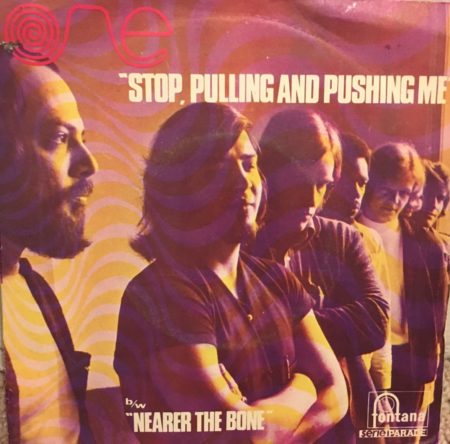
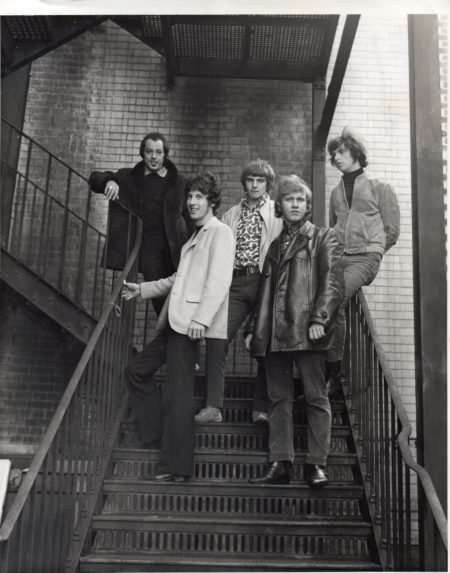
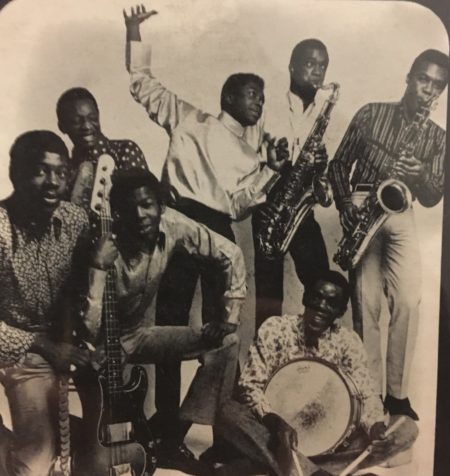
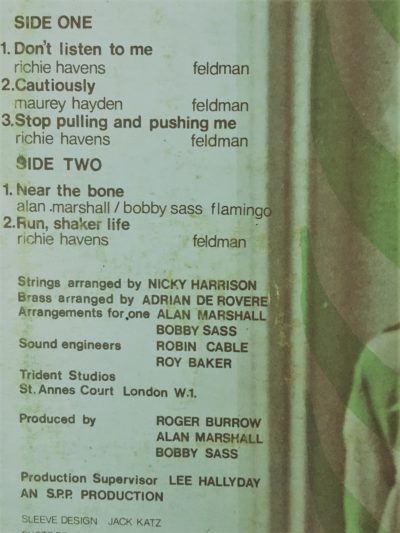 Production was split between the band’s manager Roger Burrow and Alan Marshall and Bobby Sass, working with sound engineers Robin Cable and Roy Baker. Production supervision meanwhile was handled by Lee Hallyday, who’d recently recorded his brother Johnny’s self-titled LP in France. According to several band members, the sessions at Trident’s studios also featured Alan Marshall’s former band mate from The Loose Ends and Happy Magazine, Peter Kirtley, who provided lead guitar on several cuts.
Production was split between the band’s manager Roger Burrow and Alan Marshall and Bobby Sass, working with sound engineers Robin Cable and Roy Baker. Production supervision meanwhile was handled by Lee Hallyday, who’d recently recorded his brother Johnny’s self-titled LP in France. According to several band members, the sessions at Trident’s studios also featured Alan Marshall’s former band mate from The Loose Ends and Happy Magazine, Peter Kirtley, who provided lead guitar on several cuts.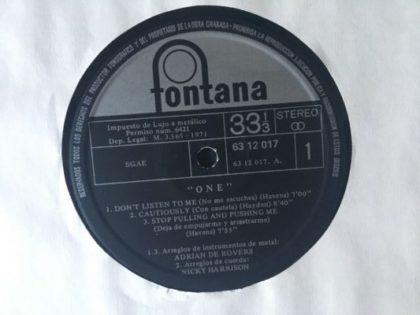 That may well be, but One’s storming cover of Havens’ “Don’t Listen To Me”, which opens the LP and third track, “Stop Pulling and Pushing Me” are inspired, extended workouts full of inventive playing and powerful instrumental passages. The musicians also do justice to “Cautiously”, an atmospheric reading of the ballad written by Maurey Hayden, singer, stand-up comedian and wife of Lenny Bruce. Alan Marshall and Bobby Sass’s “Near The Bone”, the band’s lone contribution to the song-writing stakes is also noteworthy.
That may well be, but One’s storming cover of Havens’ “Don’t Listen To Me”, which opens the LP and third track, “Stop Pulling and Pushing Me” are inspired, extended workouts full of inventive playing and powerful instrumental passages. The musicians also do justice to “Cautiously”, an atmospheric reading of the ballad written by Maurey Hayden, singer, stand-up comedian and wife of Lenny Bruce. Alan Marshall and Bobby Sass’s “Near The Bone”, the band’s lone contribution to the song-writing stakes is also noteworthy.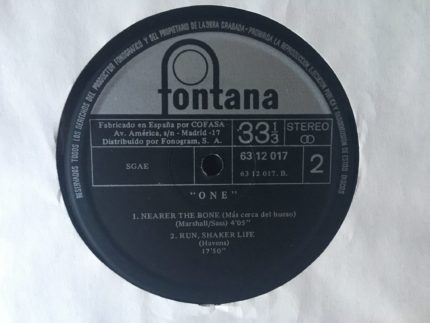 During March-April 1970, the musicians got to meet Stephen Stills, who was in London to record sessions for his first solo LP. It’s not clear who in the band made the initial contact. Marshall says that he used to leave the flat door open and musicians used to wander in. One strong possibility is Roger Burrow, who of course was a friend of Graham Nash’s. Alan Marshall, however, is pretty certain that it was Bobby Sass who ran into Stills.
During March-April 1970, the musicians got to meet Stephen Stills, who was in London to record sessions for his first solo LP. It’s not clear who in the band made the initial contact. Marshall says that he used to leave the flat door open and musicians used to wander in. One strong possibility is Roger Burrow, who of course was a friend of Graham Nash’s. Alan Marshall, however, is pretty certain that it was Bobby Sass who ran into Stills.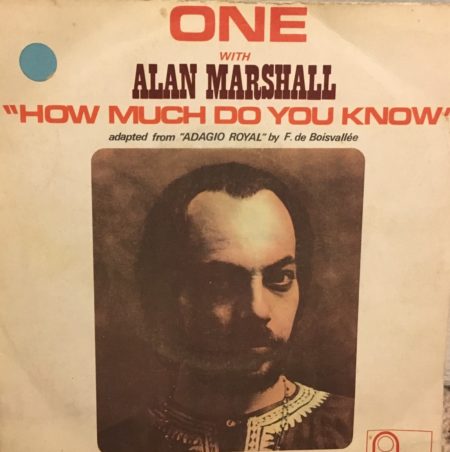 Interestingly, while One’s revolving door of personnel changes continued at pace, Fontana issued a French-only ‘45, ‘How Much Do You Know” (adapted from Adagio Royal by F de Boivallee), which was credited solely to Alan Marshall backed by One’s ‘Don’t Listen To Me”.
Interestingly, while One’s revolving door of personnel changes continued at pace, Fontana issued a French-only ‘45, ‘How Much Do You Know” (adapted from Adagio Royal by F de Boivallee), which was credited solely to Alan Marshall backed by One’s ‘Don’t Listen To Me”.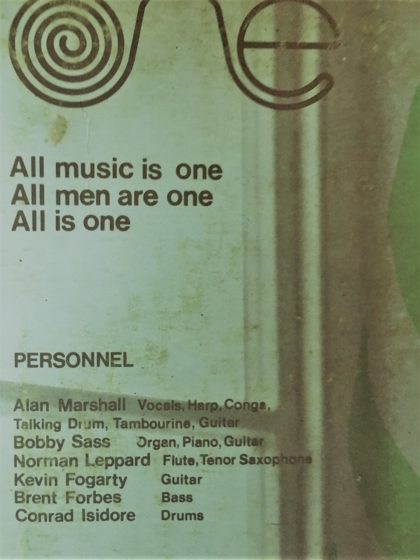 As for One, the group remains something of an obscurity. While the LP has been issued on CD by two different labels, neither appear to be official releases. Given the collectability of the record and the fact that a mint copy will probably fetch you close to £100, perhaps it’s time that the band was given a proper re-issue treatment, complete with detailed liner notes.
As for One, the group remains something of an obscurity. While the LP has been issued on CD by two different labels, neither appear to be official releases. Given the collectability of the record and the fact that a mint copy will probably fetch you close to £100, perhaps it’s time that the band was given a proper re-issue treatment, complete with detailed liner notes.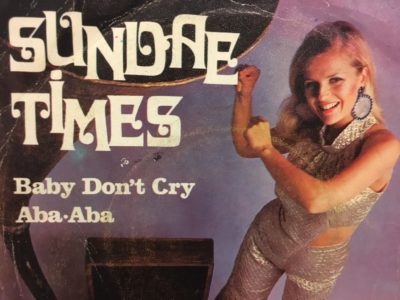 Wendell Richardson – guitar/vocals
Wendell Richardson – guitar/vocals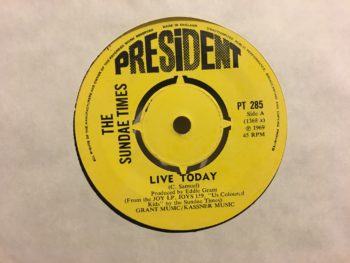 With The Sundae Times starting to pick up gigs and with further hits potentially in the pipeline, Conrad Isidore left The Toniks around September 1968 to commit to the project full-time. In retrospect, it was a sensible move as singer Colin Young quit The Toniks soon after to join British hit-makers, The Foundations.
With The Sundae Times starting to pick up gigs and with further hits potentially in the pipeline, Conrad Isidore left The Toniks around September 1968 to commit to the project full-time. In retrospect, it was a sensible move as singer Colin Young quit The Toniks soon after to join British hit-makers, The Foundations.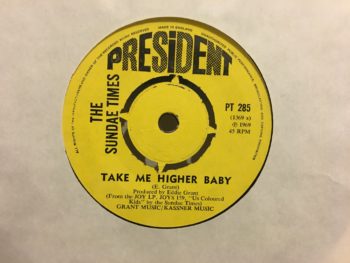 The three musicians also collaborated on three other tracks on the LP, “Take Me Back Again”, “Psychedelic Dream” and “Do You Know What Love Is”. Samuel meanwhile penned two tracks, “On The Run” and “Live Today”, which belatedly headed up The Sundae Times’ final single outing (issued on 13 March 1970), and was coupled with Eddy Grant’s “Take Me Higher Baby”.
The three musicians also collaborated on three other tracks on the LP, “Take Me Back Again”, “Psychedelic Dream” and “Do You Know What Love Is”. Samuel meanwhile penned two tracks, “On The Run” and “Live Today”, which belatedly headed up The Sundae Times’ final single outing (issued on 13 March 1970), and was coupled with Eddy Grant’s “Take Me Higher Baby”.


